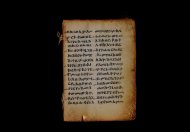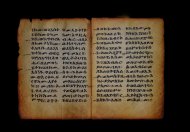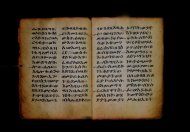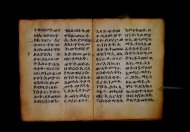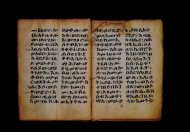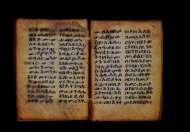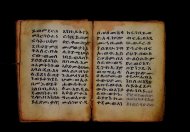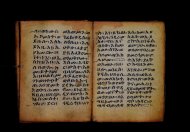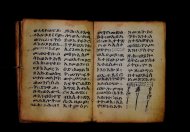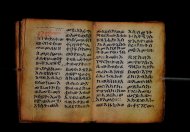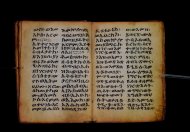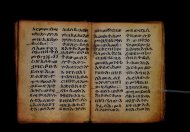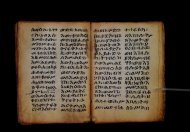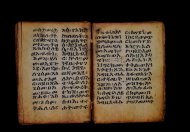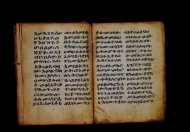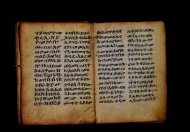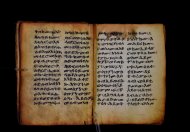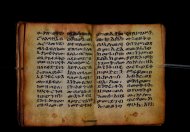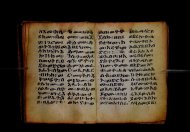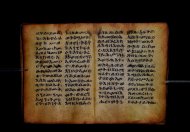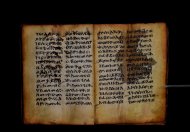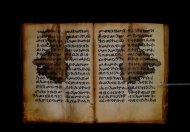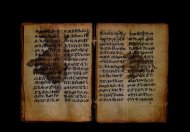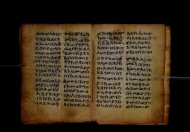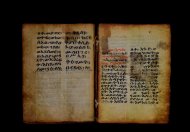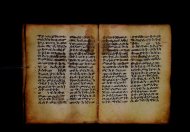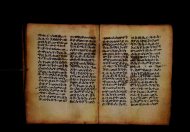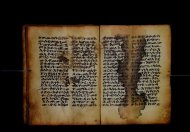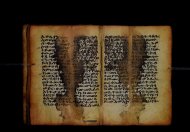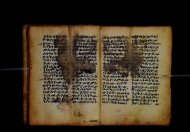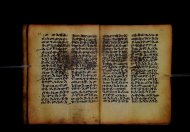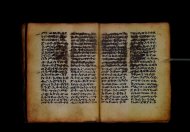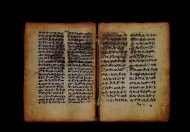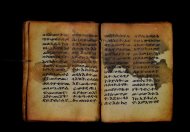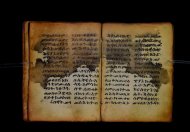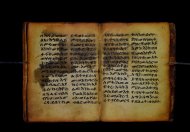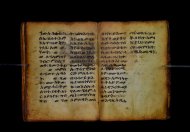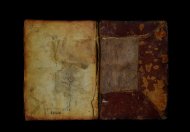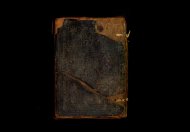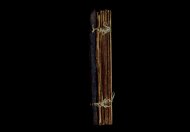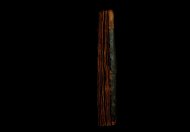|
Shelfmark |
3837 (olim Mordini 175bis) |
|
Owning institution |
Biblioteca Palatina, Parma |
|
Typology |
Codex The manuscript is composite. It consists of 2 codicological units: I (ff. 1–27), II (ff. 28–41) |
|
Copying date |
15th century, dated on a paleographical basis. |
|
Title |
Excerpt of the Zena Ǝskǝndǝr (“Romance of Alexander”), Mäṣḥafä Ṭomar (“Book of the Epistle”) |
|
Subject |
Apocrypha |
|
Language |
Gǝʿǝz |
|
Outer size (included the binding) |
174 x 128 x 75 mm |
|
Number of folia |
41 |
|
Binding |
One back wooden board covered with blind-tooled leather. Two sewing stations. |
|
Sewing |
Three S-twisted threads (each is Z-twisted) of vegetal origin. One Z-twisted thread of animal origin. |
|
Sewing pattern |
Bozzacchi C |
|
Slip case (maḫdär) |
– |
|
State of preservation of the binding |
Defective. |
|
Provenance and history |
The manuscript is mentioned by Antonio Mordini in the inventory list of the books of the monastic collection of Gundä Gunde (Mordini, A., 1953. ‘Il convento di Gunde Gundiè’, Rassegna di Studi Etiopici, 12, 29–70, p. 53 n. 6). The manuscript was purchased by Mordini in the early 1940s and became part of his private collection in Barga (Lucca). In 1994 the Italian Ministry for Cultural Heritage bought the collection, which until then had remained the property of the family of Antonio Mordini. The collection then entered the Biblioteca Palatina in Parma (cf. Fiaccadori, G., 1995, ‘I manoscritti etiopici di Antonio Mordini’. Malacoda 57 (1995), 24–27). |
Unit I (ff. 1–138)
|
Folia |
Ff. 1–27 |
|
Copying date |
15th century, dated on a paleographical basis. |
|
Short description of the content |
1. Ff. 1ra–11rb: Excerpts from the Zena Ǝskǝndǝr (the Christian “Romance of Alexander”, CAe 2616). 1.1. f. 1ra–2va l. 9: Excerpt from Ch. 22. Incipit: […]ዩከ። ወኢታአምርኑ፡ ከመ፡ ይሬእየከ፡ እግዚአብሔር፡ ዘፈጠረከ። ወይትዔገሰከ፡ እስከ፡ ትመጽእ፡ ኀቤሁ፡ ወይኳንነከ፡ አንሰ፡ አነከረከ፡ ፍቁራንየ፡ ዮም። ወአንትሙኒ፡ እለ፡ እምድኅሬየ፡ ሐልይዋ፡ ለነገርየ። 1.2. ff. 2va l. 10–9va l. 16: Excerpt from Chs 29–30. 1.3. ff. 9vb l. 1–11rb: Excerpt from Ch. 11. 2. Ff. 11va–27vb: Excerpt from a collection of sayings of the Fathers. Incipit: ዘእምአበው፡ ቅዱሳን፡ ዝንቱ፡ ቃለት፡ (sic) ሠናይ፡ ለነፍስ፡ ወጥዑም፡ ለዘይሰምዖ፡ ሰምዑ፡ ቃለቲሁ፡ (sic) ወዕቀቡ፡ ትእዛዘቲሁ፡ (sic) ኵልክሙ፡ እለ፡ በህሉና፡ እግዚአብሔር፡ ሀለወክሙ፡ እመሂ፡ መነኮስ፡ |
|
Writing material |
Goat parchment |
|
Blank folia |
– |
|
Quires |
4 |
|
Quire marks |
– |
|
Layout |
2 columns. |
|
Number of lines per column |
16–18
|
|
Ruling |
Blind ruling, from outside to inside. Lines are written above the ruling. |
|
Ruling pattern |
Nosnitsin 1 |
|
Scribe |
Unknown. |
|
Colophon |
– |
|
Additional notes |
– |
|
Decoration |
– |
|
State of preservation of the textblock |
Good. |
|
Provenance and history |
See the general description. |
Unit II (ff. 28–41)
|
Folia |
Ff. 28–41 |
|
Copying date |
15th century, dated on a paleographical basis. |
|
Short description of the content |
Ff. 28ra–41rb: Mäṣḥafä Ṭomar (“Book of the Epistle”, CAe 1978). Incipit: በስመ፡ እግዚአብሔር፡ መሓሪ፡ ወመስተ<፡>ሣህል፡ ወስመ፡ እግዚአብሔር፡ ቃል፡ ቀዳማዊት፡ ኵሎ፡ ፍጥረታተ፡ ፈጣሪት፡ ወበመንፈሱ፡ ቅዱሳዊት፡ ኅይላተ፡ ሰማያዊት፡ በከመ፡ ትንቢተ፡ ዳዊታይት፡ ሎቱ፡ ስብሓት፡ ወስግደት፡ እምትኁታት፡ ወልዑላት፡ ዘልፈ፡ ለዓለመ። |
|
Writing material |
Sheep parchment |
|
Blank folia |
41v |
|
Quires |
2 |
|
Quire marks |
– |
|
Layout |
2 columns |
|
Number of lines per column |
20–22 |
|
Ruling |
Blind ruling, from outside to inside. Lines are written above the ruling. |
|
Ruling pattern |
Nosnitsin 1 |
|
Scribe |
Unknown |
|
Colophon |
– |
|
Additional notes |
– |
|
Decoration |
– |
|
State of preservation of the textblock |
Defective. |
|
Provenance and history |
See the general description. |


